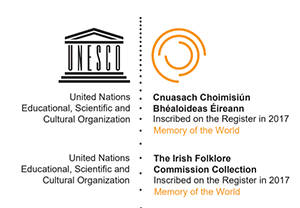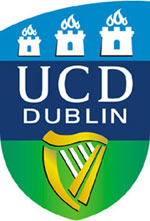National Folklore Collection inscribed into UNESCO Memory of the World Register
 In recognition of its “world significance” and “outstanding universal value to culture”, the Irish Folklore Commission Collection 1935-1970 at University College Dublin has been inscribed into the UNESCO Memory of the World Register.
In recognition of its “world significance” and “outstanding universal value to culture”, the Irish Folklore Commission Collection 1935-1970 at University College Dublin has been inscribed into the UNESCO Memory of the World Register.
The Register has a total of 427 collections and documents from around the world and includes the Magna Carta, the Diary of Anne Frank, the Bayeux Tapestry and the Book of Kells (the only other Irish entry - registered in 2011).
By 1928, the lifestyle of the Irish people was undergoing rapid and fundamental changes. “Old rural customs, such as gathering for a night of storytelling by the fireside in hospitable homes, was being abandoned. A whole culture was in danger of being discarded, unrecorded and lost forever,” noted TK Whitaker.
The Irish Folklore Commission was established in 1935 to collect and preserve Ireland’s declining oral tradition and vulnerable cultural heritage. In 1971, the Irish Folklore Commission, its staff and holdings were transferred to University College Dublin for continued development and safeguarding.
Today, the Irish Folklore Commission Collection, housed within the National Folklore Collection at University College Dublin is among the richest, most diverse tradition archives in the world. Over decades, it made thousands of tape-recordings of speech in the Irish language, but also of song and music. Photographs, sketches and other pictorial representations were also collected.
It contains almost 4,000 manuscripts of interview [transcripts] as well as native hero tales and sagas, wonder tales, local legends, poetry, historical tradition and place-name lore, in both Irish and English. These interviews contain invaluable descriptions of Irish material culture, including vernacular architecture, and traditional Irish society.
Audio and film footage from the 1940s of renowned storytellers like Peig Sayers, and performances of Irish folk drama such as “Wren Boys” and “Mummers” also form part of the collection.
There are several thousand acetate disk records of native Gaelic speakers dating from the 1940s/50s alongside a substantial collection of high quality magnetic tape recordings dating from the 1950s through to the 1960s.
Twenty-one full time (and a great many part-time and voluntary) collectors were employed by the Commission at various times throughout its existence, many of whom were in the Gaeltacht areas of rural Ireland.
UNESCO established the Memory of the World Programme in 1992 in response to a growing awareness of the precarious state of preservation of, and access to, documentary heritage in various parts of the world. War and social upheaval, as well as severe lack of resources, have worsened problems which have existed for centuries. Significant collections worldwide have suffered a variety of fates. Looting and dispersal, illegal trading, destruction, inadequate housing and funding have all played a part. Much has vanished forever; much is endangered.
The UNESCO Memory of the World Register - in some ways the most publicly visible aspect of the Memory of the World Programme - was founded on the 1995 General Guidelines and has grown through accessions approved by successive International Advisory Committee meetings.
Speaking of the announcement, Joe McHugh T.D. Government Chief Whip and Minister of State with responsibility for Gaeilge, Gaeltacht and the Islands noted,
"I am delighted that the National Folklore Collection has been awarded UNESCO Memory of the World status. This award provides due recognition of the importance of the collection, not just here in Ireland, but internationally as well. The archive which was assembled assiduously by the Irish Folklore Commission is one of the largest of its kind, comprising several thousand manuscript volumes of transcriptions, some 80,000 photographs and more than 10,000 hours of audio recordings. All of this work was carried out during a period in our history when profound language, social and cultural change was taking place. The collection therefore forms a unique record of Irish cultural life, society, the verbal arts and music. Many significant elements of the collection have been digitized and published on the Dúchas.ie website in recent years, and I look forward to the continuation of this work."
The full inscription may be viewed online at http://bit.ly/2nvpASz
